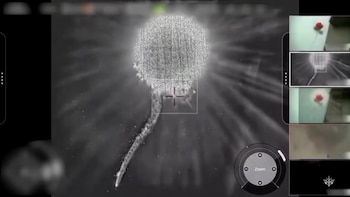The United States National Aeronautics and Space Administration (NASA) published images and data of the Moon, obtained by the probe of the Lunar Mission Reconnaissance Orbiter (LRO), never before seen.
The probe, led by a group of NASA researchers, made a different walk on our natural satellite in which it managed to film the variety of features of the lunar surface, with the help of a high-resolution camera.
The results can be seen in a video called 'Tour of the Moon 4K Redux'. Many of the places presented in the recording were known to professionals and amateurs of space science. However, some materials have been added that are only visible from space.
In addition, the video includes several of the locations where the Apollo missions landed. The NASA team has incorporated “from the mineral composition of the Aristarchus plateau, evidence of water in the form of ice near the South Pole or the mapping of gravity in and around the Eastern Basin,” as noted by the space agency itself.
From Earth
Taking stunning photos of the Moon is not a highlight only from this LRO ship. A powerful new instrument for capturing space images has given us the opportunity to explore in an incredibly detailed way the site where Apollo 15, the ninth manned mission to travel to the Moon, launched in 1971, landed in an incredibly detailed way.
To obtain the images, the device bounces a powerful radar signal off the lunar surface. This new instrument has achieved unprecedented resolution, managing to display objects as small as 5 meters.
Designed for the Green Bank Telescope in West Virginia by Raytheon Intelligence & Space, this proof-of-concept technology paves the way for even more powerful radar images in the future, potentially allowing scientists to study objects even as far away as Neptune.
Radar imaging of the moon is not a new idea. It is an extraordinarily useful tool for revealing fine structures on the surface and, at longer wavelengths, even probing more than 10 meters below the surface to observe variations in regolith density (here on Earth, this technology can help us find buried ruins).
But the Green Bank Observatory, the National Observatory for Radio Astronomy and Raytheon Intelligence & Space are all trying to push the technology even further.
In a test in November last year, the new transmitter sent a radar signal to the Moon, specifically targeting the landing site of Apollo 15, a small patch of the Moon, on a disk 3,474.2 kilometers (2,158.8 miles) in diameter, hundreds of thousands of kilometers away.
This signal, when recovered, was collected by the Very Long Baseline Array; a collection of radio telescopes in the United States basically combining to create a collector dish the size of a continent.
The result is the image below, which shows a slit at the top that corresponds to a lunar crater called Hadley C, about six kilometers wide. Next door, meandering, is the Hadley Rille, which scientists believe is a collapsed lava tube.
If the level of detail is already impressive, what comes in the future is promising and even more remarkable. With the success of these tests, the team will work on an even more powerful transmitter: a 500-kilowatt high-power radar system that will allow them to see in much more detail.
KEEP READING:
Últimas Noticias
Debanhi Escobar: they secured the motel where she was found lifeless in a cistern
Members of the Specialized Prosecutor's Office in Nuevo León secured the Nueva Castilla Motel as part of the investigations into the case

The oldest person in the world died at the age of 119
Kane Tanaka lived in Japan. She was born six months earlier than George Orwell, the same year that the Wright brothers first flew, and Marie Curie became the first woman to win a Nobel Prize

Macabre find in CDMX: they left a body bagged and tied in a taxi
The body was left in the back seats of the car. It was covered with black bags and tied with industrial tape
The eagles of America will face Manchester City in a duel of legends. Here are the details
The top Mexican football champion will play a match with Pep Guardiola's squad in the Lone Star Cup

Why is it good to bring dogs out to know the world when they are puppies
A so-called protection against the spread of diseases threatens the integral development of dogs




